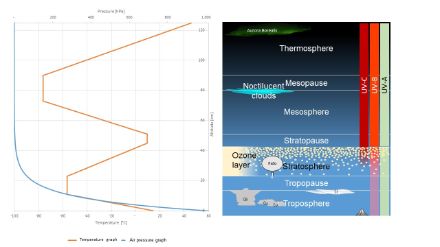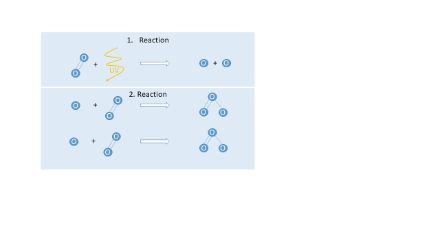Service Navigation
Search
The vertical structure of the atmosphere

Stratosphere and stratopause
The stratosphere is located above the tropopause and extends from around 25 km to 47 km in altitude. UV radiation from the sun reaches the upper edge of the stratosphere. This radiation can be divided into a UV-A wavelength range and two wavelength ranges that are harmful to health, namely UV-B and UV-C radiation.

At the upper limit of the stratosphere, UV-C radiation encounters oxygen atoms. Individual oxygen atoms naturally form a bond with other oxygen atoms to create a molecular complex (O2). When UV-C radiation encounters an O2 molecule, the radiation is absorbed, and the molecular structure is split into two individual oxygen atoms. In the process, the absorbed radiation is converted into heat.
Ozone formation and ozone depletion
In a subsequent step, the individual oxygen atoms either recombine to form an oxygen molecule (O2) or, with the involvement of a third particle, to form ozone (a foreign particle plus O3). The ozone formed in this process absorbs most of the UV-B radiation. Since the resulting ozone molecule consists of a double bond of O2 and a single bond of O, this unstable combination breaks apart again into its two components (O2 and O).
While the process of ozone formation does continue with decreasing altitude, there is less and less of the required UV-C and UV-B radiation available in the lower altitudes. Furthermore, the closer it gets towards the Earth’s surface, the less heat is released through the process, resulting in the vertical temperature gradient in the stratosphere, which rises from around -56 degrees Celsius at the bottom edge to around +9 degrees Celsius at the top edge. It is precisely this gradual increase in temperature with altitude that decouples the troposphere from the stratosphere. The stratosphere is therefore a huge inversion in this sense.
The above processes of ozone formation and ozone depletion ensure that none of the highly carcinogenic, life-threatening UV-C radiation and hardly any UV-B radiation reach the Earth’s surface. This phenomenon makes it possible for life to exist on Earth. Furthermore, as the altitude decreases, so does the ozone concentration in the stratosphere because the radiation required for the formation process is absorbed. This is also beneficial to the Earth’s biosphere, as ozone is very hazardous to health.
Ozone concentration above the Equator
Since the formation of ozone in the atmosphere is directly related to solar radiation, it stands to reason that stratospheric ozone concentration exhibits both annual and regional variations. The highest ozone concentration in the stratosphere is above the Equator. The lowest is over the poles, where ozone levels vary greatly throughout the course of a year. In the stratosphere, there is a temperature gradient from the respective summer pole over the Equator to the winter pole.
At the upper edge of the stratosphere, the air mass is decreased to the extent that there is hardly any oxygen left for ozone production. Above a transition layer in which there is no vertical temperature gradient – the so-called stratopause – the mesosphere sits at above 51 km in altitude.